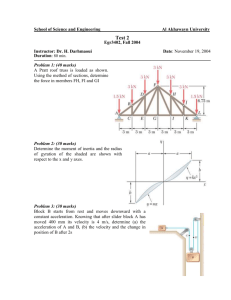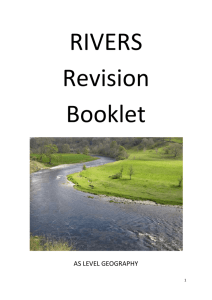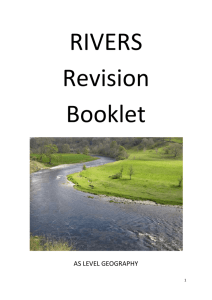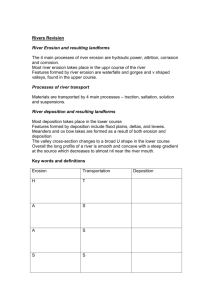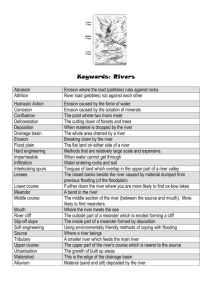RIVERSRevisionBooklet - GeoJIS-AS
advertisement
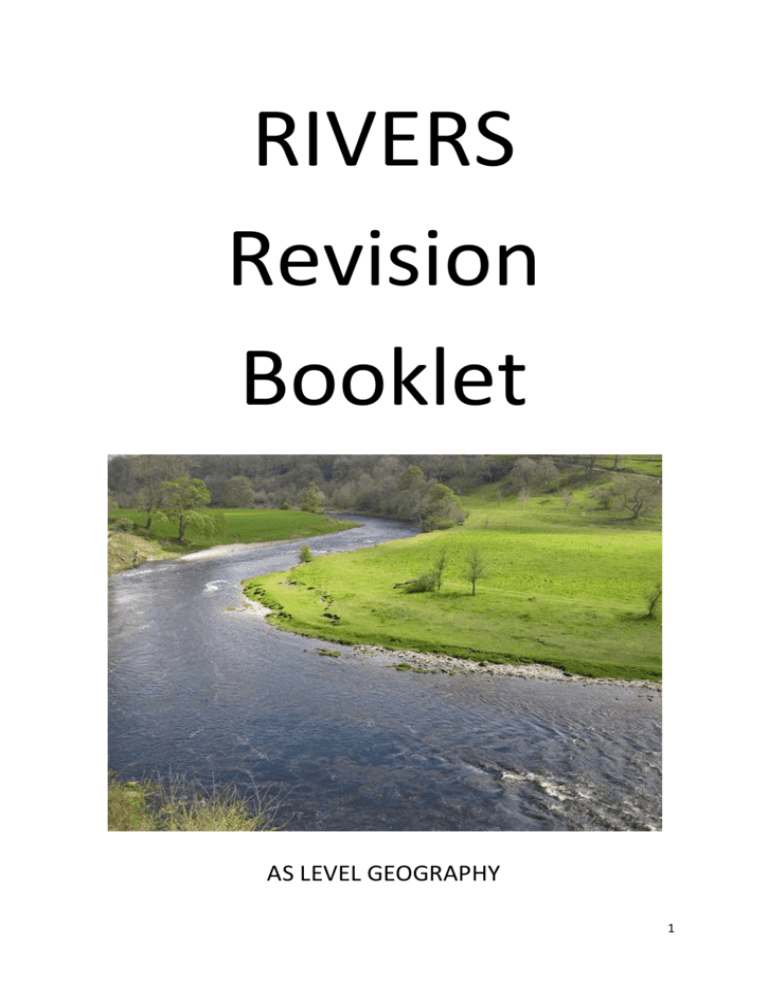
RIVERS Revision Booklet AS LEVEL GEOGRAPHY 1 2 Checklist: I can… No Sort of Yes Draw and label a drainage basin Explain what each of the flows and processes are (e.g., infiltration) Describe and explain a water balance graph Label a storm hydrograph Explain physical and human characteristics that influence the shape of a hydrograph Describe the four types of fluvial erosion Describe the four types of fluvial deposition Explain the difference between capacity and competence Explain what a Hjulstrom Curve shows Name the features found along the long profile of a river. I also can name a river case study which shows these features Explain how a channel’s characteristics varies downstream (e.g., hydraulic radius, wetted perimeter) Draw and label the change in cross-profile of a channel and valley along its long profile. Explain the formation of waterfalls, potholes and rapids Explain the formation of meanders, flood plains, levees and ox-bow lakes Explain the formation of deltas, braiding and distributaries Explain the causes of river rejuvenation and its associated landforms Explain the physical and human causes of flooding and relate this to a case study Explain the social, environmental and economic impacts of flooding and relate this to a case study Can compare the causes and impacts of flooding between LEDC and MEDC case studies Explain how flood frequency can be calculated Describe and give examples (case studies) of hard engineering strategies Describe and give examples (case studies) of soft engineering strategies Compare the relative merits of hard and soft engineering strategies 3 Quick facts: A river drainage basin is ___________________________________________________________________ _______________________________________________________________________________________ The watershed is ________________________________________________________________________ _______________________________________________________________________________________ In the box above draw a typical drainage basin. Label on the following inputs, outputs, flows and storages: precipitation, transpiration, surface run-off, interception, stemflow, infiltration, throughflow, water table, percolation, groundwater storage, groundwater flow, channel storage, evaporation, condensation Key Term Meaning Transpiration Interception Infiltration Percolation Throughflow Surface run-off Percolation Evaporation Condensation Precipitation 4 Label the following features on to your water balance graph: Precipitation (solid line) Evaporation (dotted line) Water surplus (too much water) Water deficit (too little water) Groundwater store recharge Field capacity attained The graph above is a typical water balance graph for the UK. Using the key words from the box above describe how the water balance of the UK changes with the seasons. 1) In the winter months… 2) In the summer months… 3) At the end of the summer months… Exam questions 1) Describe how water reaches a river channel in a drainage basin (4 marks) 2) Describe how the water balance of the UK changes with the seasons (4 marks) 3) Explain how vegetation can reduce the amount of water reaching a river channel (4 marks) 5 B A The two hydrographs above show how the river discharge changes over time. Describe the following features: Peak discharge _____________________________________________________________________ Peak rainfall _______________________________________________________________________ Lag time __________________________________________________________________________ Rising limb ________________________________________________________________________ Falling limb ________________________________________________________________________ Describe the main differences between the two hydrographs: 1) 2) 3) 6 River discharge (the volume of water in a river) is affected by: the amount of precipitation, the amount of evaporation and the amount of abstraction (water removed from river, e.g., for industry). It is also affected by a number of other physical and human characteristics. You will need to know the meanings to each of the following factors and how they affect the lag time. Use the key terms from page 3 to explain your answers. Drainage basin characteristics (size; steep slopes, drainage density (number of streams in the basin)): Amount of water already in drainage basin (antecedent moisture): Rock type (permeable/impermeable): Soil type: Deforestation/Afforestation: Urbanisation: 19:30 answer. (4 marks) 0 18:00 affect its storm hydrograph? Explain your 5 16:30 5) How might deforestation of this drainage basin 10 15:00 river shown to the right (2 marks) 15 13:30 4) Give the lag time and peak discharge for the 20 Boscastle hydrograph 120 100 80 60 40 20 0 12:00 Exam questions 7 Label the diagram above with the four types of fluvial erosion Erosion type C Explanation or A H A C or S A 8 The velocity of a river provides the energy needed for it to transport the eroded material. The eroded material is called its load. Which of the transport types would require the highest velocity? Transport type Explanation Traction Saltation Suspension Solution Quick facts: Competence ___________________________________________________________________________ _______________________________________________________________________________________ Capacity _______________________________________________________________________________ _______________________________________________________________________________________ Particle size _____________________________________________________________________________ _______________________________________________________________________________________ 9 Quick explanation of the Hjulstrom Curve: Particle size is along the horizontal scale, from clay to boulders. The velocity of the river is along the vertical scale. It is a logarithmic scale. The Hjulstrom curve shows how erosion, transportation and deposition vary with different river velocities Draw a line across at 100 cm/s. At this velocity the river will transport small clay particles (less than 0.01mm) and small pebbles (1050mm) that have already been eroded. It will erode (and transport) silt (0.01-0.1mm), sand (0.1-1mm) and gravel (1-10mm). It will deposit large pebbles (50-100mm), cobbles and boulders (above 100mm) Your turn… what are the velocities required to deposit, transport and erode a sand particle (size 0.1mm). Deposition: Transport: Eroson: The critical erosion velocity curve shows the minimum velocity needed to erode material. It takes a higher velocity to erode material than to transport it. The mean settling velocity curve shows the velocity at which particles are deposited. This is the equivalent to the competence of the river. 10 Describe: The pattern of the mean settling velocity curve (this is the boundary between the velocities at which particles are deposited and transported). The pattern of the critical erosion velocity curve (this is the boundary between the velocities at which particles are transported and eroded). Explain why it takes higher velocities to erode silts and clays. Disadvantages of the Hjulstrom curve: 1) Velocity – where?... 2) Shape of load… 3) Density of load… Exam questions 6) Outline the four ways a river can transport its load (4 marks) 7) Outline the four main ways a river can erode material (4 marks) 8) Describe briefly why a river a river drops its load (2 marks) 9) What is meant by the competence of a river? 10) Outline how the critical erosion curve on a Hjulstrom graph varies with particle size (6 marks) 11) Comment on the usefulness of the Hjulstrom curve as a way of determining the main processes in a river channel (6 marks) 11 Label on the diagram where the following features would be found: Waterfall Meander Rapids Potholes Delta Ox-bow lake V-shaped valley Estuary Gorge Distributary Flood plain Levee Key facts: The long profile shows the gradient of the river channel from source to mouth. The base level is the lowest point of the river (usually at the sea). Total erosion = Total deposition along the river profile. The rate of erosion/deposition can change. The river will try to smooth out any unevenness in its profile. This is called the graded profile. Upper course: High potential energy as it is so high above sea level. Middle course: High kinetic energy as the river gains velocity Lower course: Little potential energy, but lots of kinetic energy. Case study: River Temburong, Brunei (see OS map of lower/middle course at end of this document) Upper course: Ulu Temburong (Belalong), V shape valley, waterfalls and rapids Middle Course: Batang Duri to Bangar, meanders, river cliffs/slip-off slopes Lower Course: Bangar to Brunei Bay, flat peat swamps, cut-offs & ox-bow lakes 12 Quick facts: Velocity _______________________________________________________________________________ Efficiency_______________________________________________________________________________ _______________________________________________________________________________________ Wetted perimeter________________________________________________________________________ _______________________________________________________________________________________ Hydraulic radius _________________________________________________________________________ _______________________________________________________________________________________ Channel roughness _______________________________________________________________________ River A - Calculate the: wetted perimeter: cross-sectional area: hydraulic radius: River B - Calculate the: wetted perimeter: cross-sectional area: hydraulic radius: Use the words in the ‘Quick Facts’ box to describe the efficiency of a river in: Its upper course: Its middle course: Its lower course: 13 For each of the ‘courses’ comment on the shape, and whether there is mainly erosion, transport or deposition. Upper Course Middle Course Lower Course Exam questions 12) What does the long profile of a river show (3 marks) 13) What does the hydraulic radius tell you about a river, and how is it calculated? (3 marks) 14) Outline how the processes of erosion, transportation and deposition change along a river’s long profile (6 marks) 15) Explain how and why a river’s efficiency changes along it’s long profile (10 marks 14 Waterfalls Give a 7 mark account of waterfall formation: Potholes Give a 5 mark account of pothole formation: Include terms such as corrosion, drilling, uneven bed, deepening, widening in your answer Be sure to include and explain abrasion, hydraulic action, not just the word ‘erosion’. Rapids Give a 5 mark account of why rapids form: State where rapids are formed, include hard/soft rock, cataract (series of rapids), resistant, erosion. Waterfall examples: 15 Meanders Meanders are formed by erosion and deposition. Give an account of their formation (7 marks). Cross-profile of a meander. Include slip off slope, river cliff, fastest flow, erosion and deposition Ox bow lakes Explain the formation of ox-bow lakes using the four diagrams 1) 2) 3) 4) Use the key terms of erosion and deposition, alluvium, flooding, river channel, fastest flow, neck of meander in your answer. Meanders and Ox-bow lakes. An examiner will be expecting you to explain the formation of these features in detail. Make sure you explain the vertical and lateral profiles of meanders as they develop. 16 Levees and flood plains These features are formed due to flooding of the river and deposition of material. Levee Flood plain Description Explanation of formation Braiding Braiding happens when rivers are carrying a lot of _________material. If the river’s ________ drops, or the sediment _________ becomes too great for the river to carry it can be ____________ into the channel. Case study: Mississippi River Levees, flood plains and braiding are a common feature along the middle course of the Mississippi River Delta: Birds Foot Delta This causes the river to ________ into many small __________ channels that eventually rejoin to form a ___________ channel. Include the following words: Single; velocity; load; divide; deposited; winding; eroded; 17 Deltas You need to be able to describe the formation of deltas including the following key terms: Distributary, bottomset beds, foreset beds, topset beds, mouth, deposition, braiding, alluvium, low energy. Have a go… Deltas Make sure you research different types of delta: bird’s foot; arcuate, cuspate and estuarine Case study: Nile deltaThis is one of the best examples of an actuate delta as material is deposited into the Mediterranean Sea. Exam questions 16) Describe how waterfalls form (7 marks) 17) Describe and explain the formation of features formed in the middle course of a river (15 marks) 18) Describe the formation of levees (4 marks) 19) Describe the different types of delta and factors leading to their shape 18 River rejuvenation This occurs if the base level (page 11) falls. This can happen if there is a fall in sea level or crustal uplift (land rises). The fall in base level means the river has more potential energy and more potential to erode vertically. Distinctive landforms associated with river rejuvenation are: River terraces; incised and entrenched meanders; knickpoints (e.g., waterfalls and rapids). For each draw and annotate a diagram to show their formation. River terraces Incised meanders, Knickpoints Entrenched meanders Case study: River Wear, Durham 19 You should be able to come up with some obvious causes of flooding. To achieve the highest marks it is the way you explain your answers as much as your knowledge. Make sure you refer to the key terms on page 4 in your explanations and link to lag time and discharge. Use the factors that can cause flooding on page 7 to annotate the following photograph showing reasons why there could be flooding of this river. Include physical and human factors. Boscastle, Devon 20 You should always split impacts into social (affecting people – deaths, disease, homelessness); economic (affecting businesses/money) and environmental (habitats/natural environment). Social impacts Economic impacts Environmental impacts You should also be able to split your impacts into short and long term (primary and secondary effects). Short term/primary effects include damage caused immediately (or very soon afterwards) and long term/secondary effects include damage to the area over a longer period time (months/years). For a case study of your choice describe the impacts of flooding. Be specific! Exam questions 20) Outline the physical characteristics of a drainage basin that would have a high flooding risk (6 marks) 21) Explain two ways in which urbanisation increases the risk of flooding (5 marks) 21 You will be expected to distinguish between the causes, impacts and responses of floods in LEDC and MEDC. Choose from one of the case studies we have studied. If you have more information from past GCSE case studies, you are welcome to use/include this. Bullet point your answers to make it easier to revise – key facts (e.g., 100,000 people homeless). Causes MEDC: UK (2007) 1) LEDC: Bangladesh ( 1) 2) 2) 3) 3) 4) 4) ) Impacts Social: Economic: Environmental: Responses (e.g., management; rescuing people; refugee camps Exam questions 22) Using two named examples, compare the impacts of flooding in poorer and wealthier countries (15 marks) 22 Quick facts: Flood frequency _________________________________________________________________________ _______________________________________________________________________________________ Flood magnitude ________________________________________________________________________ _______________________________________________________________________________________ Recurrence interval______________________________________________________________________ _______________________________________________________________________________________ It is important to know the recurrence rate (how often a flood of a certain magnitude will occur) of a flood for management purposes. There is not much point spending millions of pounds to protect a 1 in 1000 year event! This graph explained: Floods with higher discharges (e.g., 60 m3/s-1) occur the least often (about every 15 years) Note, the scales are logarithmic to make the relationship between discharge and recurrence interval easy to see Exam questions 23) Using the figure to the right, suggest how flood recurrence could influence land use planning and building regulations in flood plain areas (6 marks) 23 Annotate the following pictures to show how they reduce flooding and the advantages and disadvantages for each. Case study: Hard engineering – Three Gorges Dam Yangtze River, China. Seasonal flooding common, however 5 major floods between 1931 and 1998. The 1954 flood killed 33,000 people; the 1998 killed 3000 people. Work began on the Three Gorges Dam (one of 46 dams along river) to control the flow. Use the table below to bullet point the positive and negative impacts of this development. Think SEE! Positive effects 1) Negative effects 1) 2) 2) 3) 3) 24 Annotate the following pictures to show how they reduce flooding and the advantages and disadvantages for each. Clockwise order: flood plain zoning (dg & photo); afforestation; wetland conservation Case study: Soft engineering – Kissimmee River, Florida (River Restoration) Exam questions 24) With reference to named examples, discuss the success of different engineering approaches to flood prevention (15 marks) 25 Key Term Definition 26 Use this space to make notes – perhaps things you need to focus on for your revision. You could also attempt some of the exam questions in this space… 27 28 29 30
